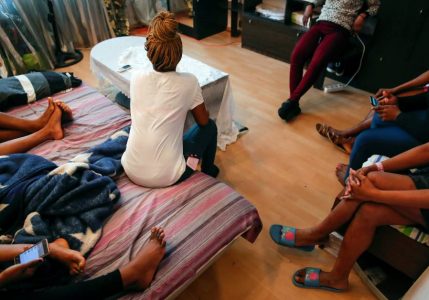
Sex trafficking on the darknet is being used to finance terrorism
Illegal trafficking of women on the darknet is likely being used as a new method of financing terrorism, says a report by IDC Herzliya’s International Institute of Counter-Terrorism exclusively obtained by The Jerusalem Post.
Written by Nadine Liv, the ICT report said that “armed groups use human trafficking as part of” their “strategy to control the local population, but it also has an economic dimension…. The revenue… from trafficking activities likely helps finance the organization’s activities.”
According to the report, studies of human trafficking, currently a $150.2 billion per year industry, until now have not examined the phenomenon “from the angle of terrorism financing.”
It said that the darknet is an ideal platform for both human trafficking and financing terrorism, and that in November-December 2018 “a trend was identified that focused on the sale of African women for the sex industry.”
Cautioning that the report “cannot present a clear link between human trafficking and terrorism financing,” it did discuss three likely examples where the link is active. Further, it noted that “the severity of the violation… justifies an in-depth study” as well as “a comprehensive response that also addresses the use of information and communication technologies as platforms” for perpetrating these crimes.
Returning to explaining why terrorist groups use human trafficking, the report explains that the initial reason is to control the population, but that terrorist groups seem to be going out of their way to propose eschatological, historical and religious justifications, which suggest wanting to use it more broadly, including for financing.
Furthermore, terrorist groups tend to flourish in armed conflict zones where regimes have fallen, the rule of law is weak, and forced displacement, poor socioeconomic status and family disintegration make human trafficking easier.
In 2017, noted the report, the secretary-general of the UN said that human trafficking can generate a return as part of the “shadow economy” of conflict and terrorism, including through sexual exploitation and sexual slavery.
For example, “victims of sexual exploitation are separated in order to extort money from their families.”
More specifically, the report stated that in West Africa and Central Africa, terrorist groups have engaged in sex trafficking or the trafficking of children to finance their activities.
In North Africa, “armed groups have been documented in control of detention and detainment centers for migrants and refugees who are likely being used as a source of financing,” said the report.
In June 2018, noted the report, there were media reports that the UN Security Council Counter-Terrorism Committee Executive Directorate was deep at work categorizing and framing the problem and linkage between human trafficking and the financing of terrorism.
ICT’s study of darknet support for human trafficking focused on the “pasting” site Stronghold Paste.
According to the report, ICT collected all of the 26 human trafficking ads that were posted to the site between November 20, 2018, and December 27, 2018. The posts were divided into four themes: the sale of black women (54% of all the ads), the sale of organs (23%), and the sale and rent of women (19%) and minor girls (4%).
ICT contacted those who posted the human trafficking ads and received naked photos of the slaves and other information which indicated that the posts were authentic.
The first concrete example of human trafficking and terrorism financing discussed by the report is ISIS.
The report stated that “the loss of Islamic State’s core territory – and consequent loss of territory-based sources of financing – creates potential for the use of trafficking in women as a source of financing.”
After the siege on the Yazidis on Sinjar Mountain in August 2014, the report stated, Islamic State fighters “separated the men from the women and children, took the young girls and abused them sexually, raped them… they were taken as sex slaves.”
“The slaves were first offered to Islamic State leaders, then to foreign buyers for $40,000, and finally to Islamic State fighters for around $165,” said the report.
ISIS itself confirmed the sexual slavery of female captives in a price list of the slaves that it distributed.
In addition, ISIS published “Questions and Answers on Taking Captives and Slaves,” which provided ideological and religious justifications for sex slavery and human trafficking… since they are barely property.” Another ISIS article justified enslaving the Yazidis because they are viewed as pagans.
Moreover, the ICT report said that in 2015 and 2016 it was reported that Islamic State in Libya had kidnapped and taken captive 540 migrants and refugees, including 63 women who were forced into sexual slavery for Islamic State fighters.
Next, the report discussed Ahman Oumar al-Dabbashi, the commander of the Al-Dabbashi militia, which operates in Libya in the coastal area between Sabratha and Melita.
It said that Dabbashi is the leader of illegal activities related to the trafficking of migrants.
According to the report, “There is evidence that the al-Dabbashi militia was directly involved in the illegal trafficking and smuggling of migrants, and that its militia controls migrants’ exit areas, camps, safe houses and boats.”
Moreover, it said that “following the violent clashes between al-Dabbashi’s militia and other militias in Sabratha, thousands of migrants were located… held under harsh conditions…. Its militia have extensive ties with Islamic State.”
Another group that the report said likely has links to human trafficking and terrorism financing, or will increase activity in that direction, is Boko Haram in Nigeria and other parts of West Africa. Part of the basis for this was the reports of Boko Haram’s heinous treatment of women. In addition, the report said that there are indications of already existing rich links between traffickers and terrorism along routes south of Nigeria – nearby to where it operates.
Source: JP





